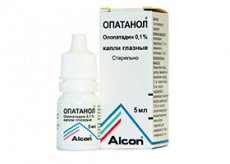Medical expert of the article
New publications
Preparations
Opatanol
Last reviewed: 04.07.2025

All iLive content is medically reviewed or fact checked to ensure as much factual accuracy as possible.
We have strict sourcing guidelines and only link to reputable media sites, academic research institutions and, whenever possible, medically peer reviewed studies. Note that the numbers in parentheses ([1], [2], etc.) are clickable links to these studies.
If you feel that any of our content is inaccurate, out-of-date, or otherwise questionable, please select it and press Ctrl + Enter.

Opatanol is a medication with antiallergic activity used for ophthalmological procedures.
The component olopatadine has powerful selective antihistamine and antiallergic properties and several mechanisms of therapeutic effect. The substance prevents the processes of histamine release (the main mediator of allergic symptoms in humans) and does not allow the stimulation of cytokine production through epithelial cells of the human conjunctiva, which develops under the influence of histamine.
 [ 1 ]
[ 1 ]
Indications Opatanol
It is used to treat conjunctivitis of allergic origin.
Release form
The element is released in the form of eye drops - inside dropper bottles with a volume of 5 ml. In a pack - 1 or 3 bottles.
 [ 4 ]
[ 4 ]
Pharmacodynamics
The drug is a selective agent that slows down the H1-ends of histamine, and in addition prevents the release of inflammatory mediators from mast cells. It has a powerful anti-allergic effect.
Pharmacokinetics
After local use, systemic absorption of the drug is low. Plasma Cmax is observed after 120 minutes.
The plasma half-life is 3 hours. The main route of excretion of the drug is the kidneys. Approximately 65% of the substance is excreted unchanged.
Dosing and administration
Before using the drops, shake the bottle with the medicine.
The medication is used daily, 2 procedures. It is required to instill 1 drop of the drug into the area of the conjunctival sacs.
Use Opatanol during pregnancy
There is limited or no information regarding the ophthalmic use of olopatadine in pregnant women. Animal studies have shown reproductive toxicity following systemic administration. Olopatadine should not be used in pregnant women or in women of childbearing potential who are not using contraception.
Animal testing has shown that the medication passes into breast milk when taken orally, so there is a potential risk to infants and newborns. For this reason, the medication is not used during breastfeeding.
Contraindications
Contraindicated for use by individuals with severe personal intolerance to the components of the drug.
Side effects Opatanol
The use of the drug can lead to the following local manifestations: conjunctival hyperemia, iritis, lacrimation, as well as keratitis, swelling in the eyelid area, blurred vision, severe pain, severe burning and a feeling of a foreign object in the eye area.
Along with this, general symptoms may appear - weakness, severe nausea, severe dizziness and headaches, as well as sinusitis with a runny nose, pharyngitis and changes in taste.
Storage conditions
Opatanol should be stored in a place closed to children. Temperature range – within 4-30°C.
Shelf life
Opatanol can be used within 36 months from the date of sale of the therapeutic substance. However, an opened bottle has only a 1-month shelf life.
Attention!
To simplify the perception of information, this instruction for use of the drug "Opatanol" translated and presented in a special form on the basis of the official instructions for medical use of the drug. Before use read the annotation that came directly to medicines.
Description provided for informational purposes and is not a guide to self-healing. The need for this drug, the purpose of the treatment regimen, methods and dose of the drug is determined solely by the attending physician. Self-medication is dangerous for your health.

